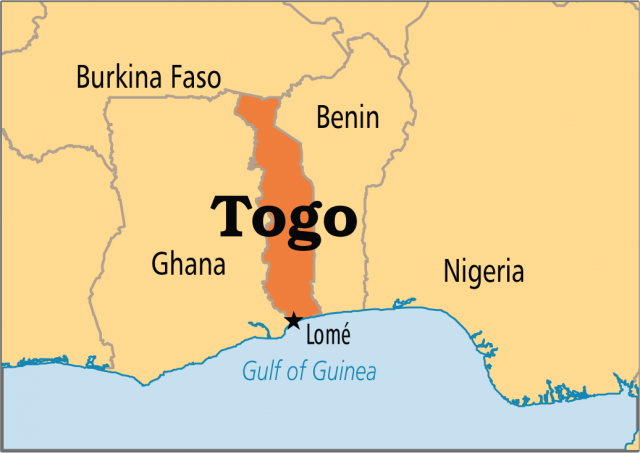Togo
Area 35,284 square mi (56,785 square km)
Population 7.115 million (2014)
Capital Lome
Highest Point 3,234 ft (966 m)
Lowest Point 0 m
GDP $4.518 billion (2014)
Primary Natural Resources coffee, cocoa, cotton, yams, cassava (tapioca).
TOGO SITS ON the southern end of the western portion of Africa. This narrow strip of land has 35 mi (55 km) of beautiful coastline and rolling hills and plateaus in the interior sections. Deciduous forests cover much of the hills and portions of the land are suitable for growing coffee. Animals such as the hippo and giraffe wander through the land, and storks and cranes can be seen flying overhead. The rainy season lasts from April to July; the hottest period is from February to March. From December to January, the dry and dusty hamattan wind blows across the region.

From the 15th century to 1960, Togo was controlled by European powers. Initially discovered by Portuguese explorers and traders in the late 15th century, this territory became a key area in the African slave trade through the 18th century. DENMARK laid claim to the country in the 1700s, but GERMANY gained control of Togoland (as it was known) after signing a treaty with the local king, Mlapa, in 1884. Germany declared control of the coastal territory and slowly moved inland.
The Germans created infrastructure, and exported the cacoa, coffee, and cotton. After Germany was defeated in World War I, the country became a League of Nations mandate and was subsequently split between the British and French. The British section of the country was named Togoland and the French section, Togo. After World War II, the entire territory became a United Nations mandate still ruled by the British and French.
In 1955, Togo became an autonomous nation, but still was part of the French union. A legislative assembly was created, and one year later, a constitution was approved. Nicholas Grunitzky became the first prime minister of the country. In 1957, British Togoland became part of the new nation of GHANA. By 1960, Togo had declared its independence with Sylvanus Olympio as president. Three years later, Olympio was assassinated in a military coup. Nicolas Grunitzky was placed in charge, but he was deposed in 1967 in a bloodless coup led by Colonel Etienne Eyadema.
In 1969, the Assembly of the Togolese People was created with Eyadema as the party president. He nationalized the foreign-owned phosphate mines. During the 1970s, Togo's economy prospered. However, when the worldwide recession hit in the early 1980s, phosphate prices dropped considerably, and Togo never fully recovered.
During the early 1990s, international leaders called on Eyadema to implement a multi-party political system in the country. Prodemocracy protest groups were formed, and citizens staged riots and strikes. Under internal and external pressure from international leaders, Eyadema stepped down from power in early 1993 and placed an interim prime minister in charge of the country. In August 1993, Eyadema won the presidential election by more than 96 percent. Throughout the 1990s and into the 2000s, Eyadema continued to rule through alleged corruption.